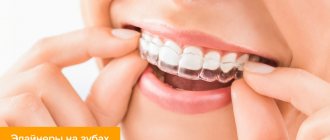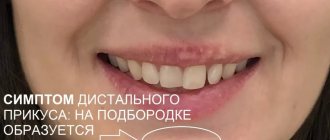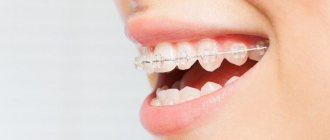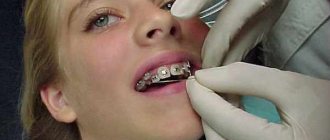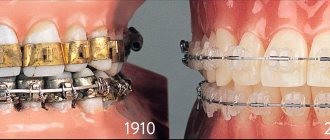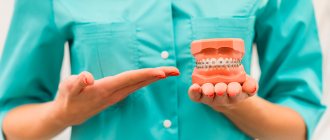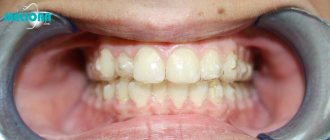Information about the brand and its manufacturer
The manufacturer of Invisalign aligners is the international company Align Technology, established in 1997 in the USA. It produces medical products. In addition to mouth guards, it manufactures intraoral scanners and also sells digital OrthoCAD services.
The products of this manufacturer are used by the best dental clinics in the world. The high quality of the product is confirmed by the fact that, since 1999, with their help more than 5 million people have effectively solved problems associated with occlusion.
Invisalign aligners are made from a clear polymer biosilicone. It is a medical grade thermoplastic material. It does not cause allergic reactions, and therefore products made from it are suitable for all people.
Types of correction programs
The essence of the action of aligners is to move teeth in the process of synchronized directed mechanical action. At each stage of therapy, certain dental elements move according to a pre-developed plan.
There are 3 adjustment programs. They are differentiated depending on the complexity of the existing defect and, accordingly, on the number of aligners:
- SuperLite – up to 7 pieces;
- Lite – up to 14;
- Full – from 10 to 40 pieces.
The choice of program is made by the doctor, in accordance with the patient’s initial data.
Indications and contraindications for treatment with the Invisalign system
Like any method, treatment with aligners has its own indications and contraindications.
Correction using the Invisalign system is indicated:
- in case of violation of occlusion, including with deep vertical overlap;
- in the presence of diastemas;
- with crowding of dental elements.
Aligners are not used:
- in correcting malocclusion in children under 12 years of age;
- in the presence of mental illness;
- for bone tissue abnormalities.
Invisalign bite correction is not noticeable from the outside
Invisalign aligners or American aligners have shown high effectiveness in straightening teeth. They are invisible in the rows as they have a transparent base. Only he himself knows that the patient is undergoing bite correction. With Invisalign you can communicate, smile, talk freely. Fitting as tightly as possible to the rows, the mouth guards create directed pressure at the right points, forcing the teeth to move along the trajectory intended for them. The effect will remain unchanged - the aligners are completely invisible in the rows and do not attract attention. Comparing the effectiveness of aligners and braces, many experts note that the former win in 30% of orthodontic treatment cases. Invisalign aligners significantly reduce treatment time and make the correction process more comfortable for the patient.
The result before and after correcting the bite with Invisalign aligners.
What is included in the diagnosis
Preliminary diagnostics in our clinic are performed using high-precision imported X-ray equipment ORTHOPHOS XG. This stage is necessary to identify indications and contraindications for occlusion correction using aligners.
The second stage of diagnosis is making individual impressions or scanning with an iTerro device, which allows you to create a 3D model of the jaws. Based on this model, personal mouth guards will subsequently be manufactured in production in the USA. When using this technology, there is no need to make physical impressions.
Based on the data obtained, a step-by-step therapy algorithm is developed using special software. ClinCheck technology allows digital interpretation to predict the progress of defect correction and visualize the final result. It should be noted that our clinic’s specialists are certified to use Align Technology products.
Advantages of aligners over braces
The two main advantages - aesthetics and wearing comfort - are due to the design of this product. This allows you not to experience embarrassment during treatment, as happens when wearing braces, when a person is embarrassed to smile and talk, experiencing stress and becoming withdrawn, refusing to communicate. Aligners eliminate such problems - they make you look the same as usual, and in extreme cases they can be removed altogether.
Aligners are more effective than braces in another respect: there are almost no restrictions on food intake. Even solid foods can be eaten if they are removed before meals. It is impossible to remove the braces for a while, so you will have to eat in them, which means you will have to give up solid food, which can break the structure, and after eating, rinse your mouth thoroughly and brush your teeth using special brushes and toothpicks, since food gets stuck between them much more strongly. teeth.
Well, difficulties in oral hygiene will result in the development of caries if the patient allows himself to relax and not be too diligent in caring for the oral cavity. When using aligners, such problems do not arise, you can eat and brush your teeth as usual.
Finally, what makes you choose aligners instead of braces is their purely medical effectiveness - treatment with aligners is faster, and you can change the aligners yourself if necessary. Aligners cover the teeth more tightly and transfer the load to them more evenly, allowing them to be moved in several axes at once, which speeds up treatment and at the same time makes it safer and more comfortable.
How is the treatment carried out?
After the finished products are delivered from the USA to our center, the administrator notifies the patient about this by phone call and schedules an appointment time. With this visit to the orthodontist, the immediate course of correction begins.
The doctor explains the rules for wearing and the frequency of self-replacement of the aligners. The dentist also gives recommendations on how to care for your mouth and aligners. As a rule, the replacement is carried out by the patient himself once every 2 weeks. To check the effectiveness of the correction process, regular visits to our clinic are planned - approximately once every 1 - 2 months (depending on the complexity of the existing defect).
It is important for the patient to commit to wearing mouth guards daily and not to violate the recommendations of the attending physician. In addition, during the initial fixation of the corrective device and during its planned replacement, there may be a feeling of pressure on the teeth for several days. This phenomenon indicates that movement of the dental elements is initiated.
After achieving the result, a course of maintenance therapy is required, i.e. it is necessary to wear a retention device (or the last aligner from the kit). This consolidates the result and prevents the teeth from gradually returning to their original position.
Food and drink intake, habits. What is better - braces or aligners?
| Eating and drinking habits | ALINERS | BRACKETS | VENEERS |
| Restrictions on food intake (diet) | Hardly ever | Yes | Yes |
| Can be removed while eating | Yes | No | No |
| Eating solid foods (nuts, crackers, etc.) | yes (without aligners, need to be removed) | No | Yes |
| Getting food between teeth when eating | No | Yes very many | No |
| Residual odor from the mouth after eating | No | Yes | No |
| Eating food with dyes | No | Yes | No |
| Alcohol consumption (over 21 years of age) | no pattern | no pattern | no pattern |
| Smoking (contraindicated when wearing or not) | acceptable | acceptable | acceptable |
Here is perhaps the most interesting information for patients. Since we eat every day and several times. Additional structures in the form of braces, aligners or veneers should, in theory, make eating problematic. After all, they can break and come off. Is it so?
Aligners have no restrictions on food intake. Braces have a lot of
No matter how strange this statement may seem, aligners are significantly superior to braces and veneers for one, but cool, reason - they can simply be removed when eating. You will not have this option if you wear braces or veneers. Therefore, if you are a food lover and cannot deny yourself the desire to chew nuts, crackers and other hard treats, make the right choice. And even if you eat in the aligners, the risk of damaging the aligner itself, although present, is extremely small, since the aligners are a fairly strong mouthguard made of special plastic.
Orthodontists recommend wearing aligners 20-22 hours a day. This means you have 2-4 hours to eat and drink. This is more than enough to eat without problems.
Braces are the leading cause of food getting stuck. Aligners are the best!
The presence of rigid bridge-like structures on the teeth in the form of wire between the braces has given the undisputed leadership in the area of food stuck to braces. Everything you eat for breakfast, lunch and dinner gets stuck in the space between the tooth and the wire. And the design of the braces themselves, which are attached to the teeth, is such that food also clings to them and remains. And, if you don’t clean out food debris, it may stay in the mouth longer than usual - at least an odor appears. And the maximum is deposits on the teeth, which can lead to the destruction of its enamel. Deposits on the teeth, plaque around braces and in places where food often gets stuck - this is not the case with aligners for one simple reason: you can remove the aligners and brush your teeth normally.
Subsequent brushing of teeth and oral hygiene (more on them below) is a complete headache for the patient. Every day, several times and much more carefully than usual. Are you ready for such a waste of time? - then this should not prevent you from installing braces.
Veneers and aligners “do not suffer from the problem” of additional teeth cleaning, since food CANNOT get stuck in the aligners, and when eating food, veneers behave just like regular teeth with appropriate subsequent care for them.
Teeth brushing and oral hygiene: braces are underdogs. Veneers or aligners?
| Brushing teeth and oral hygiene | ALINERS | BRACKETS | VENEERS |
| Difficulty with hygiene | No | Yes | No |
| The need to brush your teeth after every meal | no (rinse) | Yes | no (rinse) |
| Brushing teeth as usual without additional equipment | Yes | no irrigators, brushes, mono-beam brush | Yes |
| Possibility of using dental floss for cleaning | yes (optional) | yes (required) | yes (optional) |
| Possibility to use toothpicks | yes (optional) | yes (required) | No |
| Using special toothbrushes | No | Yes | No |
| The need to update your toothbrushes | Standard | on average once every 3 weeks (high wear) | Standard |
What do we see in the table?
As we can see from the comparison table, the teeth that are the most difficult to care for are
- when wearing braces. There’s so much that’s missing here, look how many worries arise:
- Do you need to brush your teeth and between braces after every meal? - Necessary
- Will regular brushes work? - No, we need special ones and they are used up quickly
- Is your teeth brushing routine? - No, you need jewelry and acrobatic precision to clean all the nooks and crannies of the braces supports and the contacts of the supports with wire, rubber bands, etc. quiet horror…
- dental floss? - OF SURE, the leftover food will be impatiently waiting, absurdly stuck in the braces and tooth crevices when you pull them out with a creak.
- what if you don't clean it well? — The smell of decomposing food will not take long to arrive. Brrrrrr
Second place in terms of cleaning difficulties
- veneers. In principle, there are no particular problems cleaning veneers. These are actually second teeth, tightly adjacent to the first, but ground. Here you need to think more about the quality of food, constantly check: what you eat is not particularly solid. And - constantly shake - what if it falls off and exposes the terrible skeleton/stump of the former tooth.
And there is also a huge problem with veneers: you need to know which clinic is the right place to install them. Well, patients suffer a LOT of complications due to negligence when attaching veneers. Look how it happens, don't watch it for the faint of heart!
Oh, well, we forgot the main thing - we’re talking about veneers here, but veneers are not a method of correcting a bite. This is an invasive procedure that changes the structure of the teeth. After veneers, teeth cannot be restored and you will have to wear veneers for the rest of your life.
In case of braces and aligners
- there is no such thing, these are removable orthodontic structures that are put on for a certain period of time (the braces are rigidly attached, the aligners can be removed freely), and then - after treatment there is no need to wear them and all the patient’s teeth are in order, they are all his own, not turned.
First place for cleaning comfort - aligners
Everything is absolutely natural:
- took the aligners off my teeth, ate, brushed my teeth
- rinsed the aligners
- I put the aligners back on my teeth. ALL
During meals, the aligners can be stored in a personal box - box
Well, VERY convenient. See for yourself:
Wait, the girl here hasn’t packed the aligner in the box yet. Here you can better see how convenient it is:
Duration of therapy
The time required to obtain the final result depends on the complexity of the clinical case. On average, according to the official Align Technology website, it takes about 1 year, which corresponds to 24 sets of aligners.
The doctor can announce the approximate duration of therapy in a specific situation only after diagnosis and development of an algorithm for the treatment process.
Modern Invisalign braces - advantages
Invisalign aligners cost 68,000 rubles. (without taking into account the technical part) are justified by the ease of use of the orthodontic structure. Outwardly, they resemble analogues made half a century ago and used today to whiten teeth and neutralize the effects of bruxism. Such mouth guards are not individual and are not thought out by the creators for the effective treatment of orthodontic defects. Invisalign braces were created using a completely different principle, where the structural features of the jaw apparatus of a particular patient were taken into account.
The most important advantage of aligners is the comfort of their use. While getting used to braces takes a long time, adapting to mouthguards requires minimal time. They are absolutely transparent and allow you to freely appear in public without losing confidence in your own attractiveness. In addition, Invisalign is a removable design. The mouthguards are easily removed from the mouth while eating and for hygiene procedures. If brushing your teeth with braces is difficult, then aligners allow you to carry out the procedure as usual.
Treatment with an orthodontist takes on average one to two years. It all depends on the degree of complexity of the malocclusion, the age of the patient and the adherence to the schedule for correcting the defect recommended by the doctor. With Invisalign aligners, teeth will acquire the desired position in the row only if the patient takes the treatment seriously and follows all the doctor’s recommendations.
Therefore, if a deep sense of responsibility is not inherent in the patient, to achieve the planned result it is better to use non-removable orthodontic structures such as braces. According to age parameters, Invisalign aligners are used to treat malocclusion in adolescents and adult patients. The main conditions for using the device are completion of the growth of the jaw joint.
Rules for wearing and care
Successful correction of occlusion is impossible without careful adherence to the orthodontist’s recommendations. Our dental center specialists advise:
- wear mouth guards daily for 22 hours;
- remove orthodontic products before eating or drinking hot drinks;
- brush or rinse the aligners with running water before each use;
- To clean the trays, use special pharmaceutical disinfectants or (if slightly dirty) a soft brush and paste. Note: Products cannot be boiled or washed with hot water;
- Use special containers for storage.
As you can see, the rules are simple and easy to follow.
